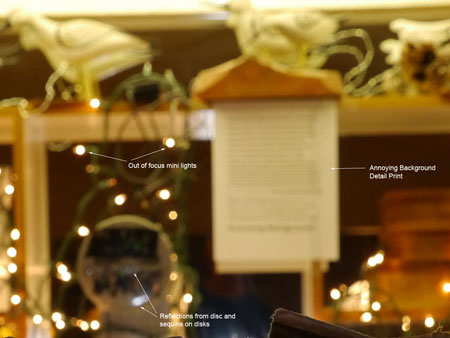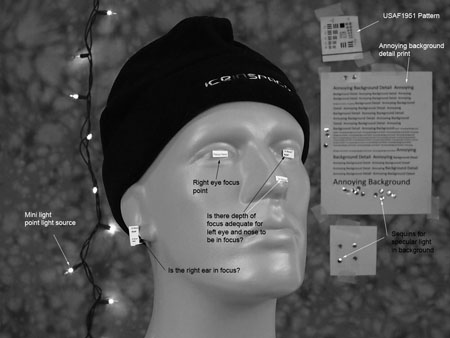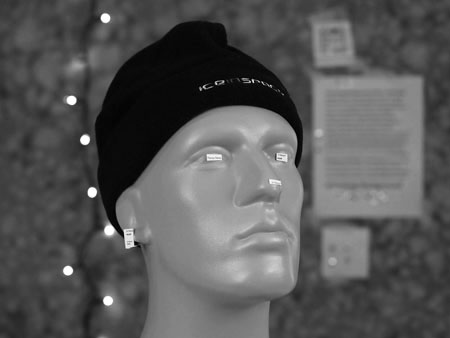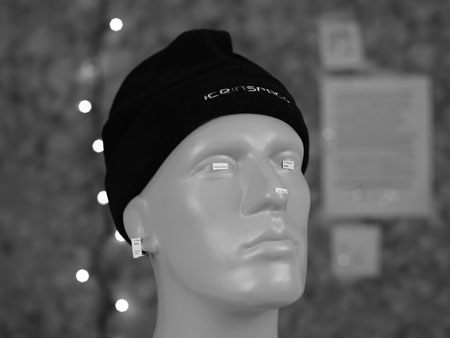MTF50 and Bokeh for 25mm Micro Four Thirds Lenses
This review compares sharpness and bokeh in still photographs of several available 25mm lenses for micro four thirds cameras as of July, 2012. The 25mm focal length is often used for photography with normal perspective and portrait application and has the equivalent field of view or perspective to a 50mm lens on a 35mm camera or full-frame DSLR. Performance of several 25mm lenses was compared with that of the 20mm Panasonic f/1.7 pancake lens that I have been using for most normal lens applications. MTF50 values were determined to assess sharpness, and two indoor scenes were photographed to evaluate out of focus background blurring characteristics of point light sources and reflected light (bokeh).
Lenses tested (size, weight and cost data):
- Panasonic 25mm f/1.4 Leica DG Summilux
- Voigtlander Nokton 25mm f/0.95
- Panasonic G X 12-35mm f/2.8 @ 25mm
- Panasonic 14-45mm f/3.5-5.6 @ 25mm
- Panasonic 20mm f/1.7
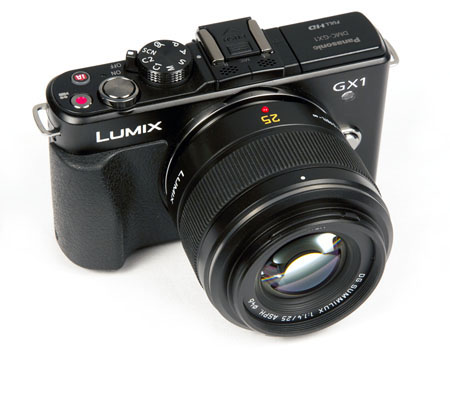 Panasonic 25mm f/1.4 Leica DG Summilux
Panasonic 25mm f/1.4 Leica DG Summilux |
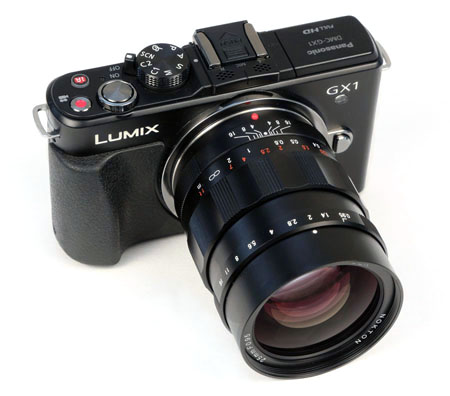 Voigtlander Nokton 25mm f/0.95 |
|---|---|
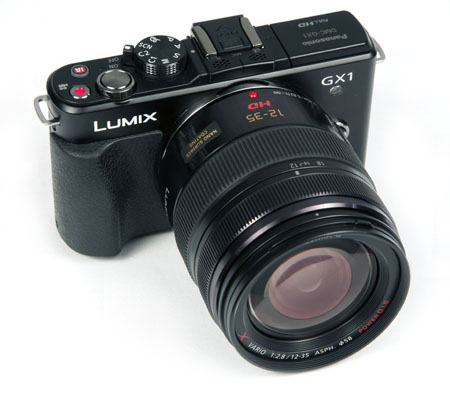 Panasonic G X 12-35mm f/2.8 |
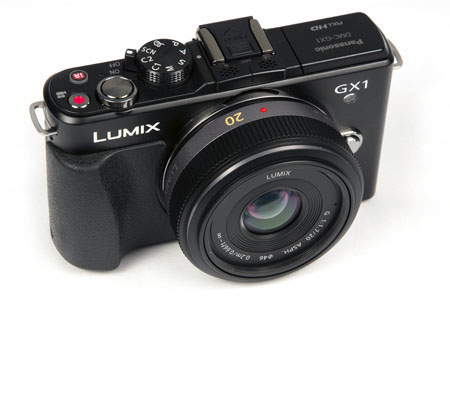 Panasonic 20mm f/1.7 |
MTF50 Results
MTF50 performance was determined using Imatest Master v. 3.7 as described using a SFRplus Chart. A 13 region, center-weighted value is posted below that includes analysis of corners. . All lenses tested showed low CA values as measured from the SFRplus Chart with Imatest Master.
Because the Panasonic G X 12-35mm lens gave lower MTF50 results at 25mm than other lenses tested, the lens was also tested at 12mm, 20mm and 35mm. It gave excellent MTF50 performance at these other focal lengths.
Imatest was also used to evaluate vignetting (light drop off), distortion and chromatic aberration (Results are summarized here).
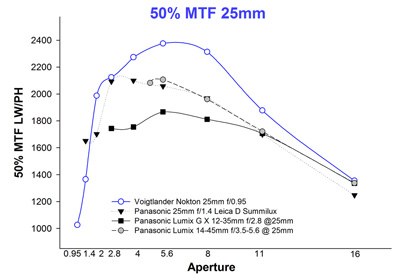 |
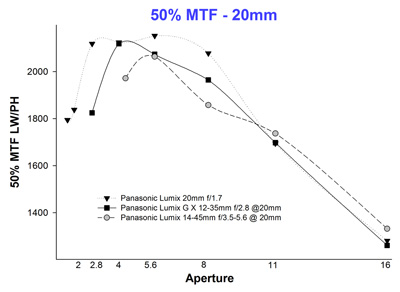 |
The 25mm 50% MTF data are plotted on a logarithmic aperture scale and broken down into center, midzonal and corner MTF plots on this page.
Bokeh Tests
Bokeh (or boke) is a photographic term originating from Japanese photographers that refers to quality of blur or fuzziness of out of focus areas due to lens design. A number of lens design characteristics influence the quality of out of focus blur (online references: Merklinger , van Walree , Atkins and Carl Zeiss) including aperture (both f/stop setting and maximal lens opening size), aperture iris shape, and degree of spherical aberration correction. Out of focus light blur qualities influencing whether out of focus blur or blur disc are perceived as pleasant or unpleasant are influenced by size of the blur disc, eveness of blur disc illumination and blur shape.
The following images
to assess bokeh produced by the tested 25mm micro four thirds lenses were taken with out of focus backgrounds containing text as well as other objects with detail as well as point light sources and objects with specular (reflected) light. The lenses differed in the size and pattern of the point light sources in the out of focus background, the size and eveness of illumination of specular light in the background and overall blurring effect. As expected, the lenses with the greatest f/stop aperture (e.g., Voigtlander 25 f/0.95) gave the most pleasing background blur. However, maximum f/stop aperture did not always predict quality of blurring. The f/2.8 Panasonic G X 12-35mm
at f/4 produced more pleasing bokeh than did the f/1.7 Panasonic 20mm lens at f/4. This effect probably had much to do with the larger overall aperture of the 12-35 (58mm filter size) versus the smaller diameter 20mm lens (46mm filter size). Greater depth of focus of the wider angle lens probably also resulted in lower levels of background blurring.
Summary of Findings for 25mm Lenses
Panasonic 25mm f/1.4 Leica DG Summilux
This lens gave the overall best performance for a 25mm lens when both sharpness at wide aperture and bokeh were considered. It could be used wide open for portrait applications and provided excellent out of focus blurring. Out of focus specular reflections were close to being evenly distributed with very minimal peripheral banding. Iris diaphragm patterns were not visible in out of focus mini light images (effect of circular iris diaphragm opening?) The lens autofocuses quickly and accurately. There is moderate vignetting at f/1.4 and f/2.
Voigtlander Nokton 25mm f/0.95
This lens gave the smoothest blurring of out of focus background. This is most clearly observed in comparisons of portrait style images at f/4. Out of focus specular light images had the most evenly distributed light pattern with no ridge formation. Blurring of the USAF1951 pattern and the text was most extensive with the Nokton. The one unusual feature of background blurring was that out of focus images of the mini lights produced strong iris diaphragm patterns in all images at f/1.4 and to a lesser extend at f/2.
The Nokton produced very soft images at f/0.95 as shown in the MTF50 plots and in the portrait style image. It also had the most severe vignetting wide open. However, when stopped down to f/2 and beyond, it was very sharp and yielded higher MTF50 values from f/4 through f/8 than did the other lenses tested. Corner MTF50 performance was far superior to that of other lenses tested. There is substantial vignetting at f/0.95 and f/1.4.
Getting optimal sharpness performance from this lens in still photographs is challenging because it is a manual focus lens. However, it can create very interesting visual effects because of its narrow depth of focus wide open.
Panasonic G X 12-35mm f/2.8 @ 25mm
At 25mm, the 12-35mm lens gave lower MTF50 scores than the other lenses tested. However, the lens had much better MTF50 performance at other focal lengths (i.e., 12, 20, 35mm). In the portrait bokeh series, blurring of out of focus areas was very good at f/2.8 and f/4 and better than that of the 20mm f/1.7 lens at f/2.8 and f/4. Out of focus specular light discs had bright outer rings suggesting overcorrection of spherical aberration. Similar effects were created when the lens was shot at 35mm (images not shown).
Panasonic 14-45mm f/3.5-5.6
This lens gave excellent MTF50 performance over the focal lengths tested. At 25mm, it was sharp from f/5 through f/8. Background blurring was negligible under the test conditions with this relatively slow (f/5) lens. The 14-45 is an older 3X zoom that came out with the G1 camera. It may be the largest of the variable aperture 3X zooms (see photo) for micro four thirds cameras, but it remains my favorite based on performance.
Summary of Performance of the Panasonic 20mm f/1.7 Pancake lens
This lens is the smallest and lightest of the lenses tested. At 20mm, it offers a wider field of view (i.e., 57 degrees versus 47 degrees for a 25mm lens). This lens has greater depth of focus than the 25mm lenses tested. In the portrait style bokeh test, the mannequin head eyes and nose were in focus at f/1.7 and f/2, and the background was attractively blurred. Background blurring was considered inadequate by f/2.8 compared to the other lenses tested. However, after running the tests, I question my need for a 25mm prime lens since I already own an outstanding 20mm f/1.7 lens that is highly portable with functional capabilities close to those of the 25mm primes. Opinions will vary depending on your shooting style and needs.
posted 19 July 2012; Updated 20 July 2012
© 2012, William L. Castleman
